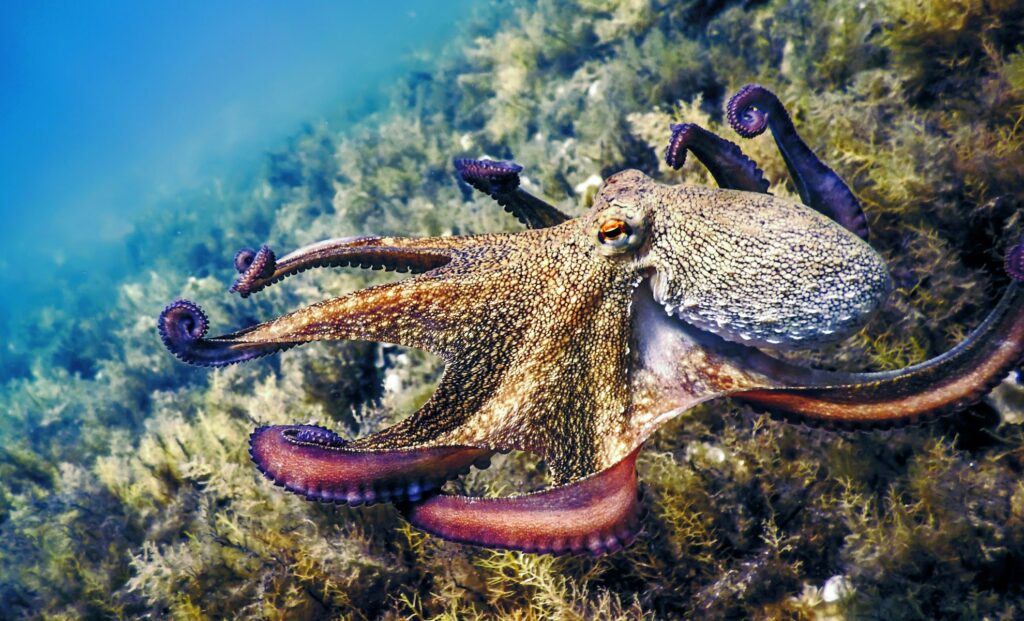The breakthrough, published in Nature Biotechnology, centers on a bioengineering method that links pigment production to bacterial survival. By genetically programming microbes to depend on pigment synthesis for life, scientists achieved yields thousands of times higher than previous attempts. According to UC San Diego’s Scripps Institution of Oceanography, this represents the first time the pigment has been produced efficiently in a living system.
Octopuses, squids, and cuttlefish rely on pigments like xanthommatin to alter the color and texture of their skin almost instantly. Their camouflage remains one of the most sophisticated biological displays in nature, inspiring years of research across biology, chemistry, and defense science. Yet, the pigment’s complexity and instability made it extremely difficult to study. The new method, developed by marine chemist Bradley Moore and his team, may finally open the door to systematic exploration of this natural phenomenon.
A New Kind of Biological Factory
Using an approach they call growth-coupled biosynthesis, the team led by Scripps Oceanography reprogrammed bacteria so that their survival depended entirely on producing xanthommatin. Leah Bushin, who conducted the research as a postdoctoral scientist at UC San Diego and now teaches at Stanford University, explained that this system “tricked the bacteria into making more of the material that we needed.”
According to the study, the researchers began with genetically weakened cells that could only grow by producing two specific compounds—xanthommatin and formic acid. For every molecule of pigment created, the bacteria simultaneously generated formic acid, which they used as fuel to sustain growth. “If the organism doesn’t make xanthommatin, it won’t grow,” Bushin said, describing how the feedback loop effectively forced the microbes to work as pigment factories.
The team reported yields of one to three grams per liter, a striking improvement over the few milligrams typically achieved through conventional methods.
Automation and Evolution at the Lab Bench
To maximize pigment production, the UC San Diego researchers employed adaptive laboratory evolution, an automated process that allows microbes to gradually evolve higher efficiency. Robotic systems helped guide the bacteria through two rounds of evolution, fine-tuning their metabolism. This process was developed by bioengineer Adam Feist, co-author of the study and a professor at the Jacobs School of Engineering.
Feist’s lab also applied specialized bioinformatics software to identify key mutations that increased pigment output and enabled the microbes to synthesize xanthommatin using a single nutrient source, such as glucose.

According to Feist, the research “gives a glimpse into a future where biology enables the sustainable production of valuable compounds and materials through advanced automation, data integration, and computationally driven design.”
Once the growth conditions were set, the researchers saw rapid success. Bushin recalled, “I’d set up the experiment and left it overnight. When I came in the next morning and realized it worked and it was producing a lot of pigment, I was thrilled.”


Expanding the Frontiers of Sustainable Materials
According to Bradley Moore, the achievement extends far beyond marine biology. The same bacterial engineering principles could be applied to manufacture other complex natural materials in an eco-friendly way. “We’ve really disrupted the way that people think about how you engineer a cell,” he said. “Our innovative technological approach sparked a huge leap in production capability.”
Xanthommatin, in addition to its role in cephalopod camouflage, also appears in insects such as butterflies and dragonflies, where it produces vivid orange and red hues. With an abundant, lab-grown source now available, researchers see opportunities for exploring its uses in photoelectronic materials, cosmetics, and UV-protective coatings. As Moore summarized in the UC San Diego release, the work “solves a supply challenge and could now make this biomaterial much more broadly available.”

